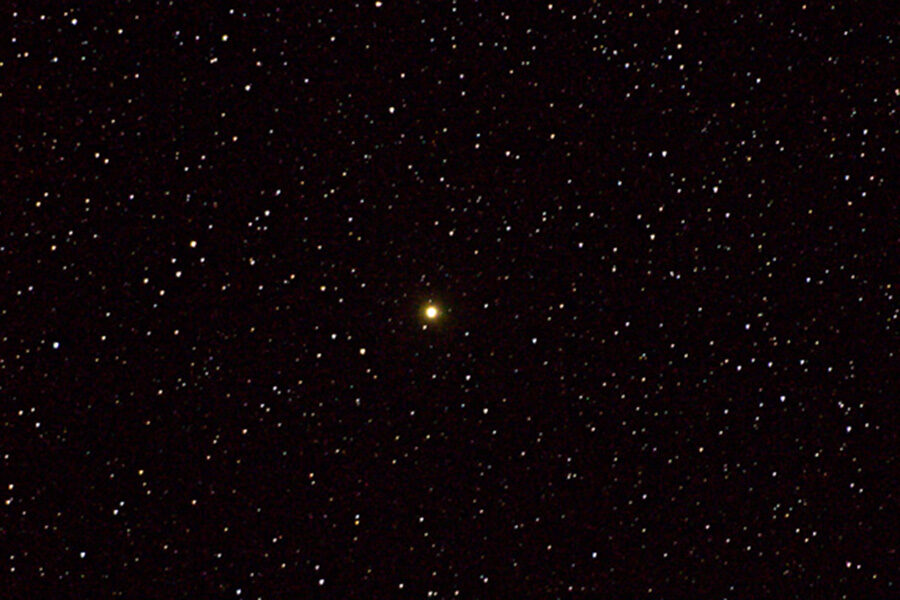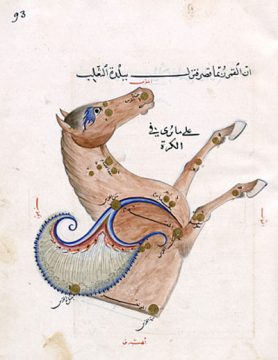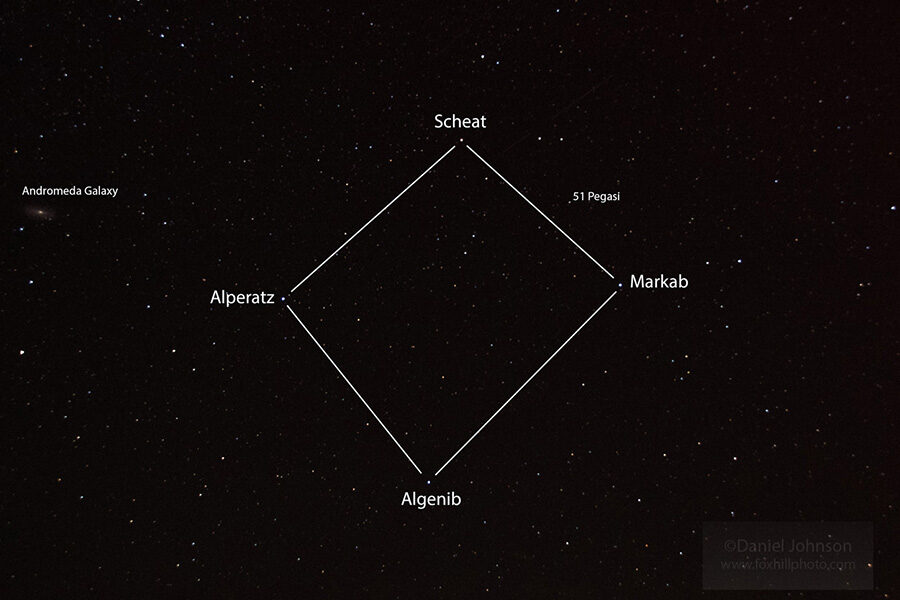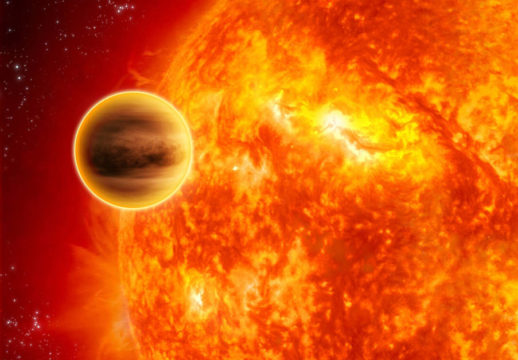Scheat Vitals
| Official name | Scheat |
| Other designations | Beta Pegasi, HR 8775, HD 217906, HIP 113881 |
| Nicknames | - |
| Apparent magnitude | 2.42 |
| Distance from Earth | 196 light-years |
| Type | M2.5 giant |
| Color | Red-orange |
| Mass | 2.1 M☉ |
| Radius | 95 R☉ |
| Constellation | Pegasus |
| Right Ascension | 23h 03m 46s |
| Declination | 28° 04' 58" |
| Multiple system? | No |
| Variable star? | Yes |
| Exoplanets status | None known |
| Probable fate | Planetary nebula/white dwarf |
Physical Characteristics

Daniel Johnson
Some of the most famous groups of stars are notable for containing mostly blue stars, accented by a single orange member. For instance, in the predominantly blue Big Dipper, Dubhe stands out as the single orange entity. In the Southern Cross, it’s Gacrux. And for the Great Square of Pegasus, the single orange star is Beta Pegasi — formally known as Scheat.
But why the orange color? Star colors are related to the surface temperature of an individual star — hotter is bluer, cooler is redder (opposite of what one might assume). A similar effect can be seen in a campfire: The cooler flames at the top of the fire are orange while the hotter flames down by the searing charcoals are blue. So red-orange stars are cooler than their bluer brethren.
Stars’ surface temperature is directly associated with their current life phase. In the case of Scheat, we’re looking at an M-type giant star that has expanded to a wide diameter. At only 2.1 solar masses, you might expect Scheat to be similar in size to the Sun, but this isn’t the case. Because of its transition into a giant phase, Scheat has expanded to be 95 times the Sun’s radius. As a result, it’s pretty rarefied and its surface is cool, and thus orange-red in color. This is a great reminder that your own eyes are a scientific instrument — even from a distance of 200 light-years, you can instantly observe a difference in temperature between stars.
Despite its cooled surface, Scheat pours out a fantastic level of energy, shining with the light of 1,500 Suns. (Much of this light comes out at infrared wavelengths.) The view through a telescope or with long-exposure photos is quite striking, with bright Scheat’s pleasant yellowish-orange color surrounded by a glowing sea of fainter stars.
Scheat is a long-period variable star, and its luminosity drifts subtly over the course of about 43 days, from 2.31 to 2.74 — enough that you can easily record this change with your own eyes or a camera. While its variability has thus far been predictable, giant stars in general are more unstable than cooler stars, as the recent dimming of Betelgeuse vividly demonstrated.
Origin / Mythology

Bibliothèque Nationale de France, Paris / IAU
Even though Pegasus isn’t super bright and doesn’t possess any stars brighter than second magnitude, it’s nonetheless well known. The fame might come partly from the constellation’s large size and easy-to-recognize square shape, but the main factor in its popularity is probably its traditional representation as a flying horse. Interestingly, one of the stars in the Great Square of Pegasus, Alpheratz, is actually the alpha star of Andromeda! While it’s not unusual for an asterism to span multiple constellations, almost all star maps actually portray Alpheratz as part of Pegasus.
In one Greek myth, a Corinthian prince named Bellerophon uses a golden bridle to control and ride Pegasus on numerous adventures. But the flying horse eventually tosses its rider when he foolishly attempts to leap over Mount Olympus. This story is in the vein of many other Greek myths that warn against hubris, or excessive pride.
In another episode, Pegasus is the mount of Zeus, who rides the flying horse into battle and eventually honors the magical equine with a spot in the sky. Pegasus aids Perseus in the rescue of Andromeda (both Perseus and Andromeda are constellations near Pegasus on the sky).
The Ojibwe tribes of North America also imagined the stars of Pegasus to form a large mammal, but used the moose (“Mooz”) instead of a horse. Hunters would pursue moose in the fall, so it makes sense that this autumn constellation would be associated with that animal.
In Chinese star mythology, Scheat is the second star of a constellation called the Encampment — a formation much smaller than Pegasus but utilizing some of the same stars. The Encampment is one of the 28 Lunar Mansions, which function a little like the Western zodiac but focus on the changing position of the Moon.
How to See Scheat

Daniel Johnson
Late summer into fall is a convenient time of year to look for Scheat and the Square of Pegasus, and it’s an interesting time for evening astronomy in general. Winter classics like Orion, Gemini, and Taurus are still out of view; instead, we hang on to a portion of the summer Milky Way. As a result, there are a slew of bright individual stars high in the south.
Throughout September and into October, the Square of Pegasus sits in the eastern sky during the evening, easy to find and pretty obvious once you go looking for it. But the Square is actually rotated into more of a diamond shape, with Scheat sitting at the peak. It’s a nice view, especially with Scheat’s orange color contrasting with the blue tones of the other three stars.
Pegasus sits right above the ecliptic — it just misses being a zodiac constellation — so the Moon passes by each month, pointing the way if you’re unsure.
While there’s more than one way to visualize this constellation, Pegasus is generally taken to be viewed upside-down from the Northern Hemisphere, with the constellation representing the front half of the horse (much like Taurus). However, if you’d like to imagine Pegasus in whole, you can always use the Pegasus from illustrator H.A. Rey of The Stars. He turned Pegasus right-side up, split the Square to remove Alpheratz, and used its remnants to form the horse’s wings. This version is less traditional but maybe more fun.
While you’re looking at Pegasus, take an easy hop over to Equuleus, a tiny, faint constellation that represents Pegasus’ foal. It’s basically just a small triangle of stars, but it’s a neglected constellation that you may not have seen before. Equuleus is generally taken to be a face portrait of the foal.

One more quick object to search for: About halfway between Scheat and Markab (Alpha Pegasi) is 51 Pegasi (formally, Helveitos), which is the home to the first exoplanet found orbiting a main-sequence star.
There’s plenty to find in this region, so take a “ride” over to Pegasus tonight and check out the bright orange star at the top of the square.
 1
1









Comments
OwlEye
October 4, 2022 at 1:33 pm
Hello Daniel,
Interesting article. I noted in the vitals you provided that Scheat (Beta Pegasi) is a variable star, and being curious as to the range and period, I went into the AAVSO database and found this SR type variable to have a range of magnitude from 2.31 to 2.74 over a period of 43.3 days on a plotted chart for beta Peg. Looking at a sample of 306 visual magnitude estimates from Jan. 1, 2020 to Sep. 2, 2022, they ranged from mag. 2.2 to 3.0 for a simple average of 2.6. Not too bad, considering the inherent difficulty of accurately estimating stars of this color!
DZ
You must be logged in to post a comment.
You must be logged in to post a comment.